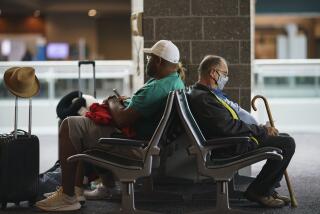Editorial: Is there a double standard on coronavirus safety for protests?

When thousands of people started crowding city streets across the nation last week to protest the killing of George Floyd by Minneapolis police officers, where was the outcry about the risk of a new COVID-19 outbreak? Why weren’t the voices that were so quick to condemn the unmasked conservatives who protested pandemic shutdowns and the crowds of unmasked hikers and beachgoers speaking out again?
It’s a good question that defies a simple answer. Was it the surprising escalation of protests? The protesters’ cause? Or the fact that it would come off as inexcusably tone-deaf to scold people about proper social distancing when they worry that they or their loved ones may be the next victims of a police shooting?
It was somewhat mollifying that the images from Los Angeles and other cities showed most protesters wearing face coverings — a thin line of defense against infection, but better than nothing. This suggests that protesters understood the risk involved, calculating that staying inside and safe from the virus was ultimately more dangerous to their lives.
That’s fundamentally different from the decision made by protesters who defied social distancing rules and mask guidance while demanding that pandemic restrictions be lifted. Those were deliberate moves to demonstrate their (incorrect) belief that COVID-19 wasn’t much of a threat and that authorities were needlessly crushing businesses and the economy.
The reality is that large gatherings of people, regardless of their ideological bent or cause, jeopardize the success that has come out of months of shared sacrifice to slow the spread of the coronavirus and protect those most vulnerable, including black Americans who are dying of COVID-19 at a higher rate than most anyone else. The U.S. might seem to have overcome the virus because businesses have started reopening. But while the pandemic is waning in some parts of the country that were exposed early, COVID-19 cases are climbing in others. And public health officials warn that the protests may spark another wave of infections. If that’s the case, we will know in about two weeks.
It may be too late to stop spikes from past protests, but not too late to curb future protest-driven transmission. Protesters should heed calls to get tested after participating in demonstrations and follow the recommendations for isolation if they have been exposed. Law enforcement officials also must examine their own tactics, including the shocking lack of masks worn by police officers working protest detail. While they’re at it, they need to reconsider using tear gas and other weapons that cause people to sneeze and cough out respiratory droplets and to observe proper social distancing measures while arresting protesters.
More to Read
A cure for the common opinion
Get thought-provoking perspectives with our weekly newsletter.
You may occasionally receive promotional content from the Los Angeles Times.






